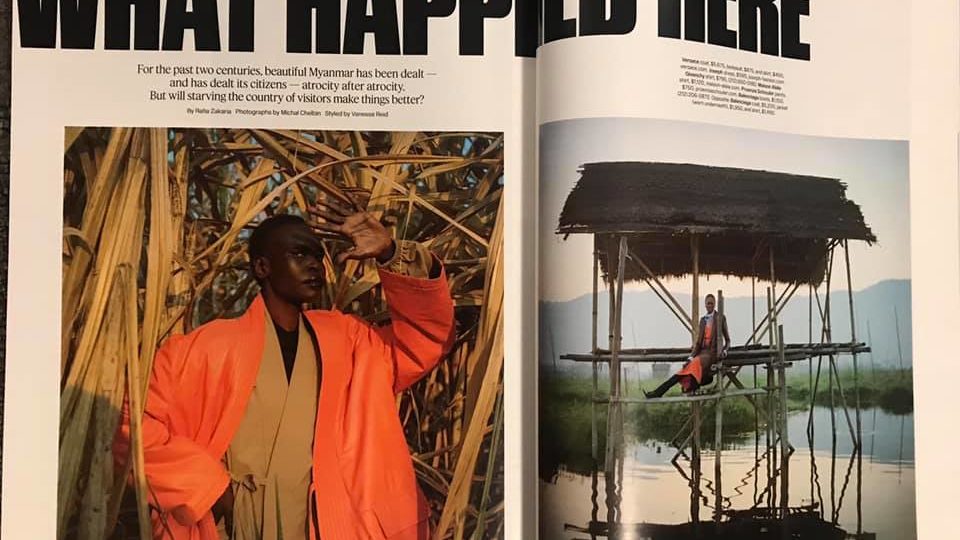A decision by New York Times Style Magazine editors to pair an article on Myanmar’s struggles with its “brutal history and violent present” with a high-end fashion shoot has prompted a social media backlash among activists and journalists alike, with more than a few describing the decision as insensitive and tasteless.
Titled “The Quandary of Myanmar: Will Starving the Country of Visitors Make Things Better?,” the May 15 feature attempts to draw parallels between the British colonial occupation and the present-day military campaign that has viciously expelled more than 730,000 Rohingya Muslims as it examines the ethics of spending tourist dollars in the country.
While the article itself employs language seemingly nostalgic for a country frozen in time — including lines that wouldn’t be unfamiliar from travelogues of another era (read: “The golden light will seduce you,” “otherworldly stillness”) — it’s the decision to pair it with a glossy high-fashion photo spread that has raised eyebrows.
“Using genocide to promote high-end fashion shows quite a lack of judgement and sensitivity. It’s a bizarre feature,” Mark Farmaner, director of rights NGO Burma Campaign UK, told Coconuts Yangon in an interview today.
“It used genocide as a backdrop for a fashion shoot, makes the case against a tourism boycott which doesn’t exist, and manufactures a history of Burma which simply isn’t true.”
Matthew Smith, co-founder and chief executive at Fortify Rights, called the decision a “profound misjudgment.”
“The idea that genocide and mass atrocities would be a suitable backdrop to sell luxury fashion is not only insensitive, it’s reprehensible,” he said.
https://www.facebook.com/greg.constantine/posts/2315342075170891?__xts__[0]=68.ARByZNrAxXGDy72XcY-E39RCbpw1cT9AO3ausdCkInaFoD6WHHhuyOclGTPvIdSfKa1N5Xkjg54O0IYRPj29_-cbasSKvnLHRPCdPwanzkuRI_KghHbyUwBLk8XdxM84jou8HDJMbzNPrRnoLGtQM_aHQr19oMVxoYj7UKzPYD6jQde8fPVf3sFoEwN4gZxa3KdchseVopyPSowC&__tn__=-R
After covering acts of genocide against the #Rohingya for the past couple years and seeing it reduced to fashion, tourism, and a photo shoot is quite a low blow. @nytimes @rafiazakaria https://t.co/PpHy1WDeB9
— Tania Rashid (@TaniaRashid9) May 21, 2019
Genocide and fashion, that doesn't seem to be the most appropriate or ethical combination, right? Some frivolous prick of an editor at the @nytimes thought it was. https://t.co/ElFaKVi8L2 https://t.co/BkUn165KuE
— Carlos Sardiña Galache (@CSGalache) May 21, 2019
While the critics reserved most of their venom for the editorial decision to pair the article with the fashion spread, Rafia Zakaria, author of the piece in question, slapped back at critics on Twitter, defending her work as “saying what needs to be said” and arguing that those taking issue with it were “trolls.”
However, as one journalist pointed out, those taking issue with the article/photo spread were, by and large, established journalists who have covered the Rohingya crisis for years.
https://twitter.com/Allison_Joyce/status/1130838301764726784
https://twitter.com/seanjgleeson/status/1130834306178248704
Youth advocate and political activist Thinzar Shunlei Yi told Coconuts Yangon that while she appreciated the attempt by the NYTimes to highlight Myanmar’s issues, they botched the execution.
“I feel bad when these stories are mixed up with fashion items and touristic view. Genocide isn’t a marketing strategy or background to sell things,” she said.
Activist Ro Nay San Lwin, coordinator at the Free Rohingya Coalition, pointed out what he deemed the most glaring argument against tourism as a positive act — the fact that visitors can’t even access the areas where the wide-spread atrocities have been documented.
“No tourists or journalists are allowed to visit Rakhine State. So what the author has written is not a reality,” he told Coconuts Yangon. “By visiting the country, no one will know what is going on on the ground.”
The fashion shoot, unsurprisingly, came in for even harsher criticism.
“It is shameful that genocide is exploited by advertising expensive fashion items where atrocities on Rohingyas were mentioned,” he said.
“It is clear that corporations do not care about the lives of tens of thousands of innocents who were killed by [the] brutal Myanmar regime. It is like they put the expensive fashion clothes on corpses and are inviting the visitors to visit the graveyard.”
Coconuts Yangon has reached out to the NYTimes Magazine via email for comment.




